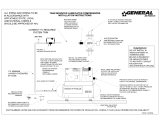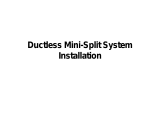
4
Safety Information
English
Safety Information
Safety Information
‐ Area that can cause leakage of combustible gas
and suspension of carbon fibers, flammable dust, or
volatile flammables.
‐ Area where refrigerant leaks and settles.
‐ Area where animals may urinate on the product.
Ammonia may be generated.
• Do not use the indoor unit for preservation of food
items, plants, equipment, and art works. This may cause
deterioration of their quality.
• Do not install the indoor unit if it has any drainage
problem.
• For the multi system, this indoor unit can be
conncected to an R-32 or R-410A outdoor unit. Check
the type of refrigerant in the outdoor unit.
• Because your air conditioner contains R-32 refrigerant,
make sure that it is installed, operated, and stored it
in a room whose floor area is larger than the minimum
required floor area specified in the following table:
Wall-mounted type
m (kg) A (m²)
≤ 1.842
No requirement
1.843 4.45
1.9 4.58
2.0 4.83
2.2
5.31
2.4 5.79
2.6
6.39
2.8 7.41
3.0 8.51
‐ m : Total refrigerant charge in the system
‐ A : Minimum required floor area
• IMPORTANT: it’s mandatory to consider either the
table above or taking into consideration the local law
regarding the minimum living space of the premises.
• Minimum installation height of indoor unit is 0.6 m for
floor mounted, 1.8 m for wall, 2.2 m for ceiling.
Installation of the outdoor unit
• While in installation or relocation of the product, do
not mix the refrigerant with other gases including air
or unspecified refrigerant. Failure to do so may cause
pressure increase to result in rupture or injury.
• Do not cut or burn the refrigerant container or pipings.
• Use clean parts such as manifold gauge, vacuum pump,
and charging hose for the refrigerant.
• Installation must be carried out by qualified personnel
for handling the refrigerant. Additionally, reference the
regulations and laws.
• Be careful not to let foreign substances (lubricating oil,
refrigerant, water, etc.) enter the pipings. The application
of oil or refrigerant deteriorates the pipings to result in
drain leakage. For storage, securely seal their openings.
• When mechanical ventilation is required, ventilation
openings shall be kept clear of obstruction.
• For disposal of the product, follow the local laws and
regulations.
• Do not work in a confined place.
• The work area shall be blocked.
• The refrigerant pipings shall be installed in the position
where there are no substances that may result in
corrosion.
• The following checks shall be performed for
installation:
‐ The charging amount depends on the room size.
‐ The ventilation devices and outlets are operating
normally and are not obstructed.
‐ Markings and signs on the equipment shall be
visible and legible.
• Upon leakage of the refrigerant, ventilate the room.
When the leaked refrigerant is exposed to flame, it may
cause generation of toxic gases.
• Make sure that the work area is safe from flammable
substances.
• To purge air in the refrigerant, be sure to use a vacuum
pump.
• Note that the refrigerant has no odour.
• The units are not explosion proof so they must be
installed with no risk of explosion.
• This product contains fluorinated gases that contribute
to global greenhouse effect. Accordingly, do not vent
gases into the atmosphere.
• Because the working pressure for R-32 is 1.6 times
higher than that for R-22, use exclusive pipings and
tools specified. In case of replacing an R-22 model with
an R-32 model, be sure to replace the conventional
pipings and flare nuts with exclusive ones.
• The models that use the refrigerant R-32 have a
different thread diameter for the charging port to
prevent charging failure. Therefore, check its diameter
(12.70 mm) in advance.





















